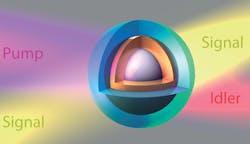Infrared optical parametric amplifier (OPA) is smaller than a blood cell
In contrast to conventional tabletop optical parametric amplifiers (OPAs), a type of OPA created by researchers at Rice University's Laboratory for Nanophotonics (LANP; Houston, TX) is 15 times smaller than a red blood cell.1 The output from Rice’s nanoscale OPA can be tuned over a range of frequencies that includes a portion of the infrared spectrum.
"Tunable infrared OPA light sources today cost around a $100,000 and take up a good bit of space on a tabletop or lab bench," said study lead author Yu Zhang, a former Rice graduate student at LANP. In contrast, the Rice OPA is 400 nm in diameter.
Shrinking an OPA IR light source to such a small scale could open doors to new kinds of chemical sensing and molecular imaging that aren't possible with today’s state-of-the-art nanoscale infrared spectroscopy, says Zhang.
Surface plasmon-enhanced difference frequency generation is achieved by integration of a nonlinear optical material, barium titanate (BaTiO3), in nanocrystalline form within a plasmonic nanocavity. While the pump laser in Rice's device has a fixed wavelength, both the signal and idler frequencies are tunable.
"People have previously demonstrated nanoscale infrared lasers, but we believe this is the first tunable nanoscale infrared light source," says LANP Director Naomi Halas.
One of LANP's specialties is the design of multifunctional plasmonic nanoparticles that interact with light in more than one way. Zhang says the nanoscale OPA project required LANP's team to create a single particle that could simultaneously resonate with three frequencies of light.
"There are intrinsic inefficiencies in the OPA process, but we were able to make up for these by designing a surface plasmon with triple resonances at the pump, signal, and idler frequencies," Zhang says.
Source: http://news.rice.edu/2016/05/09/rice-experts-unveil-submicroscopic-tunable-optical-amplifier/
REFERENCE:
1. Yu Zhang et al., Nano Letters (2016); doi: 10.1021/acs.nanolett.6b01095
About the Author
John Wallace
Senior Technical Editor (1998-2022)
John Wallace was with Laser Focus World for nearly 25 years, retiring in late June 2022. He obtained a bachelor's degree in mechanical engineering and physics at Rutgers University and a master's in optical engineering at the University of Rochester. Before becoming an editor, John worked as an engineer at RCA, Exxon, Eastman Kodak, and GCA Corporation.

